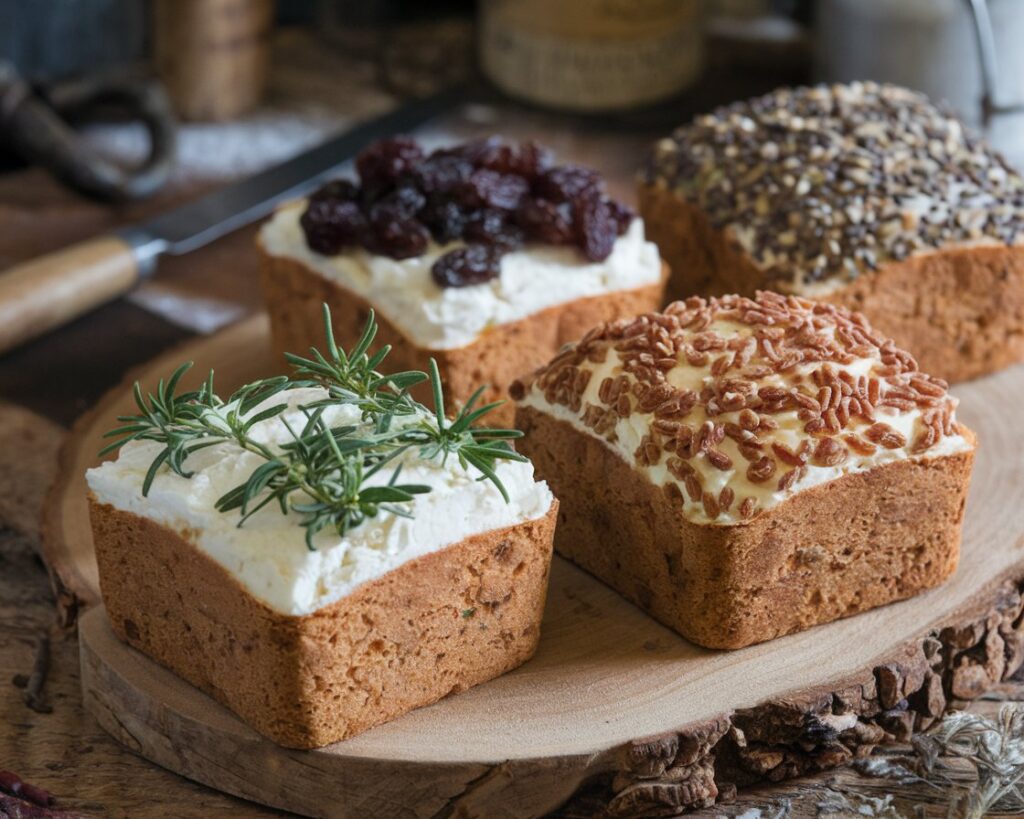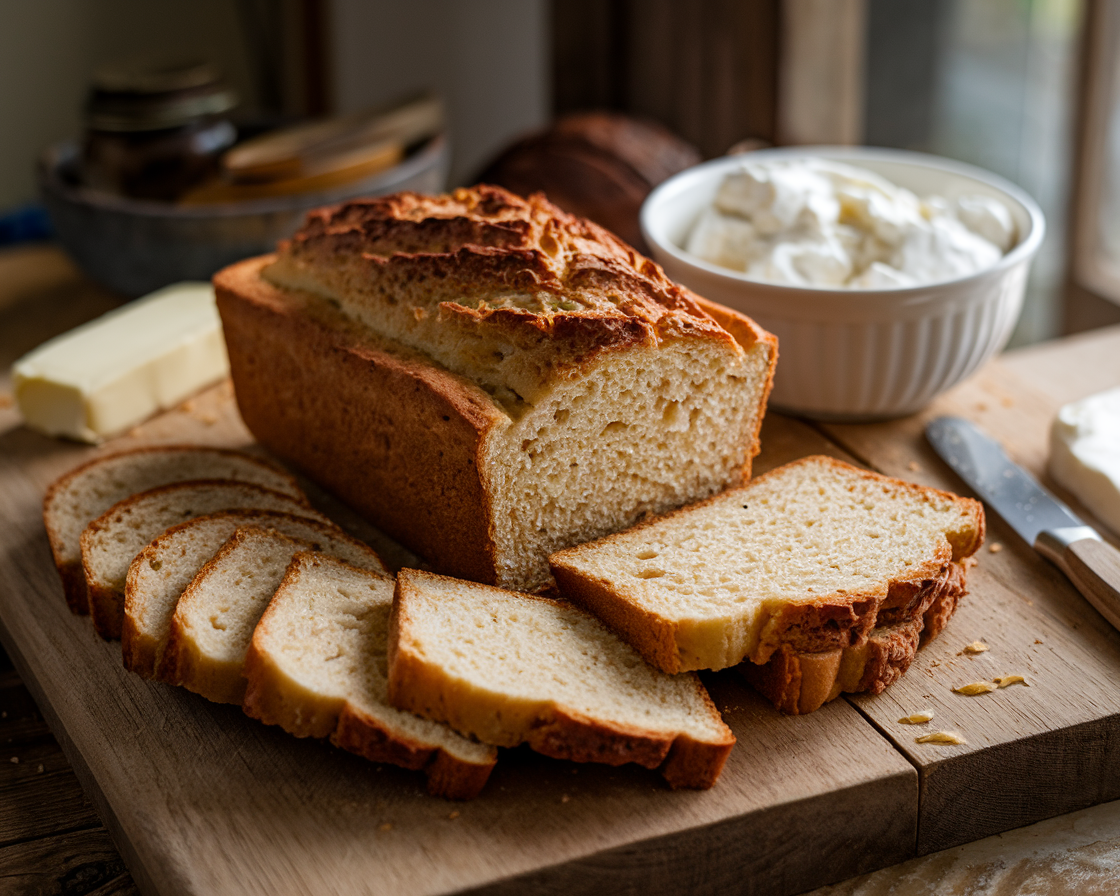Bread-making has a magical way of bringing warmth and comfort into our homes. But what if you could elevate your bread to not only be delicious but also more nutritious? Enter cottage cheese bread—a loaf that combines the soft, airy texture of homemade bread with the protein-packed goodness of cottage cheese. Whether you’re a seasoned baker or just starting out, this recipe will surprise you with its simplicity and flavor.
Introduction to Cottage Cheese Bread
What is Cottage Cheese Bread?
Cottage cheese bread is a soft, slightly tangy loaf made by incorporating cottage cheese into the dough. The result is a unique bread that’s not only flavorful but also rich in protein and moisture. It’s perfect for sandwiches, toasting, or simply enjoying with a pat of butter.
“Cottage cheese bread isn’t just bread—it’s a wholesome twist on a classic that turns every slice into a satisfying treat.”
Why Cottage Cheese Makes Bread Better
Adding cottage cheese to bread enhances its texture and nutrition. The moisture from the cheese keeps the bread soft for days, while its protein content boosts the nutritional value of each slice. Plus, the subtle tangy flavor pairs beautifully with both sweet and savory toppings.
Ingredients for Cottage Cheese Bread
Essential Ingredients for the Dough
To make the perfect cottage cheese bread, you’ll need these key ingredients:
| Ingredient | Quantity |
|---|---|
| All-Purpose Flour | 3 cups |
| Cottage Cheese (blended) | 1 cup |
| Active Dry Yeast | 2 teaspoons |
| Warm Water (110°F) | ½ cup |
| Honey or Sugar | 2 tablespoons |
| Salt | 1 teaspoon |
| Olive Oil | 2 tablespoons |
| Egg | 1 (optional for brushing) |
Optional Add-Ins for Flavor and Texture
Get creative by adding fresh herbs like rosemary or thyme for a savory twist. For a sweeter version, mix in a tablespoon of honey and a handful of raisins. Seeds like flax or chia can also be sprinkled on top for extra texture.
Choosing the Right Cottage Cheese
For the best results, choose a creamy full-fat cottage cheese. If you prefer a smoother texture, blend the cheese in a food processor before adding it to the dough.
“The right cottage cheese makes all the difference—smooth, creamy, and ready to elevate your bread.”
Step-by-Step Guide to Making Cottage Cheese Bread
Preparing the Dough
- Start by proofing your yeast: combine the warm water, honey (or sugar), and yeast in a small bowl. Let it sit for 5-10 minutes until it becomes frothy.
- In a large mixing bowl, combine the flour and salt. Make a well in the center and add the yeast mixture, olive oil, and blended cottage cheese.
- Mix the ingredients until a sticky dough forms. Transfer the dough to a floured surface and knead for about 8-10 minutes until it becomes smooth and elastic.
Shaping and Proofing the Loaf
- Shape the dough into a loaf and place it in a greased loaf pan or on a baking sheet for a freeform style. Cover with a damp cloth and let it rise in a warm spot for 1-1.5 hours or until it doubles in size.
Baking and Cooling the Bread
- Preheat your oven to 375°F (190°C). For a shiny crust, brush the top of the loaf with a beaten egg before baking.
- Bake the bread for 30-35 minutes or until the top is golden brown and the loaf sounds hollow when tapped.
- Let the bread cool completely on a wire rack before slicing to ensure the best texture.
“Patience is key—cooling your bread allows the flavors and textures to fully develop.”
Tips for Perfect Cottage Cheese Bread
How to Achieve the Right Dough Consistency
The consistency of your dough is crucial for a soft and airy loaf. If your dough feels too sticky, gradually add a tablespoon of flour at a time while kneading. On the other hand, if the dough feels dry or crumbly, add a teaspoon of water or olive oil. The goal is a smooth, elastic dough that bounces back when pressed gently.
Ensuring Even Baking
For even baking, preheat your oven and place your loaf in the center rack. Using a thermometer can help you achieve perfect results—bread is ready when its internal temperature reaches 190°F (88°C). If the top browns too quickly, cover it loosely with foil for the last 10 minutes of baking.
Storing Your Bread for Maximum Freshness
Store your cottage cheese bread in an airtight container or wrap it in plastic wrap to keep it soft. It can last up to 3 days at room temperature. For longer storage, slice the bread and freeze it in a sealed bag. Simply toast the slices straight from the freezer for a quick treat.
Variations of Cottage Cheese Bread
Herb and Garlic Cottage Cheese Bread
Add fresh herbs like parsley, rosemary, or chives to your dough for a savory twist. Mixing in minced garlic cloves or garlic powder further enhances the flavor. This version pairs perfectly with soups or as a side for Italian dishes.
Sweet Cottage Cheese Bread with Honey
For a sweeter option, add a tablespoon of honey and a sprinkle of cinnamon to your dough. Fold in raisins or dried cranberries for bursts of sweetness. This version is ideal for breakfast or as a snack with butter or jam.

Gluten-Free Cottage Cheese Bread
Use a gluten-free flour blend to make this recipe suitable for those with gluten sensitivities. Adjust the liquid content slightly, as gluten-free flours tend to absorb more moisture. The result is a tender and delicious loaf that everyone can enjoy.
Common Problems and Solutions
Why is My Bread Dense?
Dense bread often happens when the dough isn’t kneaded enough or the yeast doesn’t activate properly. Make sure your yeast is fresh and proofed correctly. Kneading the dough until it’s smooth and elastic helps develop gluten, giving the bread its airy texture.
Fixing Dough That Won’t Rise
If your dough isn’t rising, the environment may be too cold. Place the bowl in a warm spot, such as near a window or in an oven with the light on. Adding a pinch of sugar to the yeast mixture can also help activate it.
Preventing a Dry Loaf
Dry bread can result from overbaking or using too much flour. Keep an eye on the baking time, and use a thermometer to check for doneness. If the dough feels dry during mixing, add a little more cottage cheese or water to restore moisture.
Pairing Suggestions for Cottage Cheese Bread
Best Spreads and Toppings
Cottage cheese bread pairs wonderfully with a variety of spreads and toppings. For a savory option, try spreading it with herb butter, cream cheese, or avocado slices sprinkled with salt and pepper. If you’re in the mood for something sweet, honey, fruit preserves, or Nutella make excellent choices. Each topping enhances the bread’s mild, tangy flavor and creates a satisfying snack or breakfast.
Soups and Sides That Go Well with the Bread
This bread is an ideal companion for hearty soups like tomato basil, chicken noodle, or creamy mushroom. Its soft texture and slight tang make it perfect for dipping into flavorful broths. You can also serve it alongside salads or roasted vegetables for a well-rounded meal. Whether you’re making a light lunch or a comforting dinner, cottage cheese bread adds that extra touch of warmth.
Cottage Cheese Bread for Special Occasions
Holiday-Themed Cottage Cheese Loaves
Turn your cottage cheese bread into a festive centerpiece for holidays. Shape the dough into a wreath, braid it, or use cookie cutters to create decorative designs on top. Adding dried cranberries, rosemary, or a sprinkle of coarse sea salt can give it a seasonal flair. It’s a crowd-pleaser that looks as good as it tastes.
Mini Cottage Cheese Rolls for Parties
For parties and gatherings, make mini cottage cheese rolls instead of a full loaf. These bite-sized portions are perfect for serving with dips or spreads. Arrange them in a basket with a cloth liner for an inviting presentation. They’re easy to grab, share, and enjoy, making them a favorite at potlucks or family dinners.
Explore More Ideas
From Savory Lasagna to Sweet Cookies: Explore More Recipes with Cottage Cheese and Zesty Treats
If you’re loving the idea of incorporating cottage cheese into your recipes, why stop at bread? Dive into our Lasagna Recipe with Cottage Cheese for a savory dish that’s hearty, wholesome, and bursting with flavor. This lasagna offers a lighter twist on the classic recipe, using cottage cheese to create a creamy and protein-packed layer that complements the rich marinara sauce perfectly. It’s a great dinner option that combines comfort and nutrition in every bite.
For those with a sweet tooth, don’t miss our guide on How to Make Blueberry Lemon Poppy Seed Cookies. These cookies are a delightful mix of tangy lemon and sweet blueberry flavors, enhanced by the nutty crunch of poppy seeds. Perfect as a snack or dessert, they pair beautifully with a warm cup of tea or coffee.
Both recipes showcase the versatility of ingredients like cottage cheese and lemon, proving that a single ingredient can transform a dish into something extraordinary. Whether you’re craving a savory main course or a sweet treat, these recipes will inspire you to get creative in the kitchen!
Frequently Asked Questions (FAQs)
Can I use low-fat cottage cheese for this recipe?
Yes, you can use low-fat cottage cheese if you prefer a lighter loaf. However, full-fat cottage cheese will give the bread a richer flavor and softer texture.
How do I store cottage cheese bread?
To keep the bread fresh, store it in an airtight container or wrap it in plastic wrap at room temperature for up to 3 days. For longer storage, slice the bread and freeze it in a resealable bag for up to 2 months.
Can I make this recipe without yeast?
Yes, you can adapt this recipe to be yeast-free by using baking powder or baking soda as a leavening agent. The texture will be more like quick bread but still delicious.
Why is my bread not rising?
If your bread isn’t rising, the yeast may be inactive. Ensure the water you use to proof the yeast is warm (around 110°F) but not too hot, as heat can kill the yeast. Additionally, allow the dough to rise in a warm, draft-free environment.
Can I add seeds or nuts to the dough?
Absolutely! Adding sunflower seeds, flaxseeds, or chopped nuts can enhance the flavor and texture of the bread. Sprinkle some on top before baking for an extra crunch.
Conclusion: The Versatility and Benefits of Cottage Cheese Bread
Cottage cheese bread is more than just a loaf—it’s a blend of nutrition, flavor, and creativity. Its soft texture and protein-packed goodness make it a versatile addition to any meal, whether you’re enjoying it with a hearty soup or spreading it with your favorite jam. With endless variations and easy customization, this bread suits every occasion, from casual breakfasts to festive celebrations. So, why not give it a try? With simple ingredients and a little love, you can bake a loaf that’s as satisfying as it is wholesome.
“Baking cottage cheese bread isn’t just making bread—it’s creating moments of comfort and joy in every slice.”

